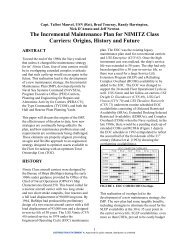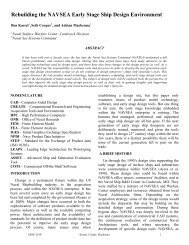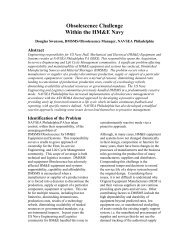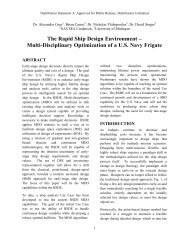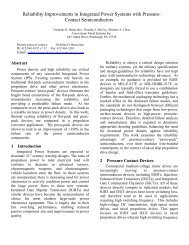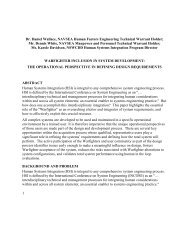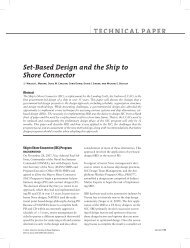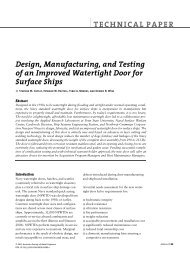The Wreck of DKM Bismarck − A Marine Forensics Analysis 1 The ...
The Wreck of DKM Bismarck − A Marine Forensics Analysis 1 The ...
The Wreck of DKM Bismarck − A Marine Forensics Analysis 1 The ...
Create successful ePaper yourself
Turn your PDF publications into a flip-book with our unique Google optimized e-Paper software.
<strong>The</strong> <strong>Wreck</strong> <strong>of</strong> <strong>DKM</strong> <strong>Bismarck</strong> <strong>−</strong> A <strong>Marine</strong> <strong>Forensics</strong> <strong>Analysis</strong><br />
guns by more than 5,000 meters.) Painfully aware <strong>of</strong> the vulnerability <strong>of</strong> the Hood, the British<br />
were attempting to close the range and lessen the risk <strong>of</strong> destruction resulting from plunging fire.<br />
Less than ten minutes after opening fire, Hood blew up and sank, destroyed by 381-mm shellfire<br />
which penetrated to and detonated her magazines.<br />
<strong>The</strong> ammunition on Hood was destroyed by deflagration <strong>−</strong> intense burning (<strong>of</strong> some 112<br />
tons <strong>of</strong> cordite) with no means to dissipate its energy vertically or horizontally <strong>−</strong> which wrecked<br />
the Hood’s hull structure, causing the ship to break apart into two sections before beginning its<br />
plunge to the sea bed.<br />
A KEY HIT ON THE BISMARCK’s BOW<br />
Abeam <strong>of</strong> the capstans on the forecastle <strong>of</strong> <strong>Bismarck</strong> is a large oblique-shaped hole in the<br />
starboard side, above the water line and Batteriedeck 6 and forward <strong>of</strong> the 60-mm splinter belt. It<br />
occurs just above the forward edge <strong>of</strong> a faded painted fake bow wave. <strong>The</strong> hole is clearly bent<br />
outward, apparently from the effects <strong>of</strong> a shell passing through the ship from the port side 7 . An<br />
elongated hole in the deck above was first thought to be the entry hole for this round, but careful<br />
measurement indicates the two holes are unrelated.<br />
<strong>The</strong> entry hole on the port side was not imaged, as there were a number <strong>of</strong> shell holes<br />
noted in the area where the shell was believed to have entered. <strong>The</strong> exit hole is consistent with a<br />
trajectory through the bow with an angle <strong>of</strong> fall <strong>of</strong> about 15 degrees and a shell path from astern.<br />
This is consistent with the expected angle <strong>of</strong> fall for a shell fired by Prince <strong>of</strong> Wales at a range <strong>of</strong><br />
about 16,000 meters <strong>−</strong> refer to Table 2.<br />
Table 2<br />
Range Table Data for the 356-mm Gun 8<br />
Range Angle <strong>of</strong> Fall Striking Velocity<br />
13,720 meters 11.5 degrees 526 meters per second<br />
18,290 meters 18.2 degrees 476 meters per second<br />
<strong>The</strong> shell’s path was an oblique one from port to starboard across Compartments XX and<br />
XXI; the second, third, and fourth watertight compartments aft <strong>of</strong> the forward perpendicular<br />
(XX, XXI, and XXII) were damaged by fragments caused by the passage <strong>of</strong> this heavy projectile<br />
through the ship. <strong>The</strong> entry hole is above the Batteriedeck, while the exit hole, above that deck<br />
or near that deck’s intersection with the side shell. <strong>The</strong> plating around the exit hole is bent<br />
outward. <strong>The</strong> condition <strong>of</strong> the exit hole in the <strong>Bismarck</strong>’s starboard bow supports the judgment<br />
that the shell passed through the ship without exploding 9 .<br />
Compartments XX and XXI are roughly centered on the fore capstans, which correspond<br />
perfectly to the exit hole. Since the exit hole was slightly above the waterline but was within the<br />
bow wave, water flowed in and eventually flooded compartments on the Upper, Middle and<br />
Lower Platform Decks. <strong>The</strong> ship’s trim down by the bow aggravated this problem. <strong>The</strong> reserve<br />
oil tanks were located in way <strong>of</strong> the shell trajectory, but below the Middle Platform Deck. Hence<br />
we believe that none <strong>of</strong> the reserve tanks were affected by this shell’s trajectory. If there was a<br />
6 This is the Second Deck in the US Navy.<br />
7 LT Gerhard Junack mentioned in correspondence with William Garzke that the shell passed through the<br />
ship without exploding. We believe it may have detonated in the water adjacent to the ship.<br />
8 John Campbell. Naval Weapons <strong>of</strong> World War Two. London: Conway Maritime Press, Ltd., 1985.<br />
9 Admiral Lütjens reported this in a message after the battle was over.<br />
6



